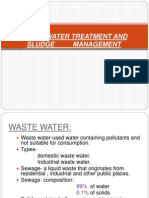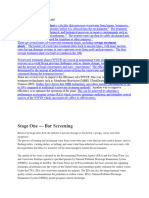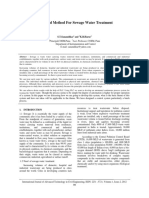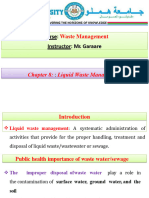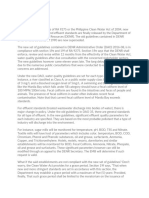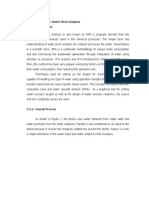Chapter 5 Sewage Treatment Plant
Chapter 5 Sewage Treatment Plant
Uploaded by
JasleneDimarananCopyright:
Available Formats
Chapter 5 Sewage Treatment Plant
Chapter 5 Sewage Treatment Plant
Uploaded by
JasleneDimarananOriginal Title
Copyright
Available Formats
Share this document
Did you find this document useful?
Is this content inappropriate?
Copyright:
Available Formats
Chapter 5 Sewage Treatment Plant
Chapter 5 Sewage Treatment Plant
Uploaded by
JasleneDimarananCopyright:
Available Formats
CHAPTER 5: SEWAGE TREATMENT PLANT
To protect water resources and the greater environment, all waste from buildings
and industrial processes must be treated to meet certain standards of quality. Domestic
sewage from dwellings and DWV systems in buildings are permitted to be discharged
into the public sewers system, which provides the necessary treatment prior to tits
discharge into nature.
Water Treatment and Disposal
Basic Purposes of sewage treatment
1. To destroy pathogenic micro organisms. Pathogens are disease-causing
bacteria.
2. To remove most suspended and dissolved biodegradable organic materials.
Raw or untreated sewage is mostly pure water since it comprises about 99.9% water
and only about 0.1% impurities. However, sewage contains biodegradable organic
material, which is very likely to contain pathogenic micro organisms.
The amount of pathogens in the waste water is expected to be proportional to the
concentration of fecal coliform bacterium cal E. coli (Escherichia coli). The E. coli
concentration in raw sanitary sewage is about 1 billion/ liter, but it is not a pathogen. In
fact, our bowels will not function properly without it, but as an indicator organism, the
presence of E. coli indicates that water is contaminated with fecal wastes and
pathogens maybe present. DENR standard is 10,000 MPN/ 100ml.
• For water to be safe for drinking the E. coli count shall not be more than 1 E. coli
per 100ml (about 0.4 cup) of water.
• For water to be considered safe for swimming the E. coli shall be more than 200
E. coli per 100ml of water.
Biological Oxygen Demand (BOD). The measure of the strength of the sewage in
relation to the total amount of organic material it contains. Untreated domestic sanitary
sewage has an average BOD of about 200mg/ liter. DENR standard is 50 mg/ liter.
Total Suspended Solids (TSS). The measure of the strength of the sewage in relation
to the total amount of suspended solids. Untreated domestic sanitary sewage has an
average TSS of 240 mg/ liter.
Another group of impurities that is of major significance in waste water is the
compounds of nitrogen (N) and phosphorous (P) from plant nutrients. Raw sanitary
sewage contains an average of 35mg/ liter of nitrogen and 10 mg/liter of phosphorous.
THE SEWAGE TREATMENT PROCESS
The sewage treatment process may be divided into four major steps:
1. Preliminary treatment. 35% of BOD and 60% of TSS are removed.
2. Primary Treatment, which is subdivided into:
• Sedimentation and retention: raw sewage is retained for the preliminary
separation of indigestible solids and the start of aerobic action.
• Aeration: introduction of air through natural convection or mechanical
blowers to accelerate the decomposition of organic matters.
• Skimming: Removal of scum that floats on top of the partially treated
sewage.
• Sludge Removal: disposal of heavy sludge at the bottom of treated
sewage.
In the primary treatment, 85% of BOD and 85% TSS are removed.
3. Secondary Treatment, namely, the removal of colloidal and dissolved organic
material.
4. Tertiary Treatment, that is, the removal of dissolved nitrogen and phosphorous
and disinfection of effluent by the addition of chemicals, such as chlorine (10
mg/liter).
Sewage Treatment Plants
The design of sewage treatment plants for large buildings, building complexes and
municipalities follows precisely the same processes described above. However, modern
treatment plants do require considerable mechanized equipment and controls in order
to be efficient and reliable. Sanitary Engineers or Plumbing Engineers who specialized
in the subject do the design of these treatment plants.
Following are the definitions of some commonly used terms related to the subject of
sewage treatment methods and disposal processes:
1. Digestion- That portion of the sewage treatment process in which biochemical
decomposition of organic matter takes place, resulting in the formation of simple
organic and mineral substances. Also known as aerobic (bacterial) digestion.
2. Influent- Untreated sewage flowing into a treatment system.
3. Effluent- Treated or partially treated sewage flowing out of a treatment system.
4. Sedimentation- Formation of layers of heavy particles in the influent
5. Aerobic (bacterial) digestion- Digestion of the waste through the natural bacteria
digestive action in a tank or chamber.
6. Active Sludge- The sewage sediment, rich in destructive bacteria, which can be
used to break down fresh sewage more quickly.
7. Filtration- a means of filtering out any solid matter from the effluent.
8. Disinfection- A process to disinfect the effluent with chemicals.
9. Percolation- the flow or trickling of a liquid downward through a filtering medium.
A summary of waste water treatment.
You might also like
- Chapter 3 Plumbing FixturesDocument21 pagesChapter 3 Plumbing FixturesJasleneDimarananNo ratings yet
- How Industrial Businesses Can Reduce Production Costs With Reverse Osmosis: Industrial Reverse OsmosisFrom EverandHow Industrial Businesses Can Reduce Production Costs With Reverse Osmosis: Industrial Reverse OsmosisRating: 5 out of 5 stars5/5 (1)
- 1-d. Stress On An Oblique Plane Under Axial Loading: A F A VDocument7 pages1-d. Stress On An Oblique Plane Under Axial Loading: A F A VJasleneDimarananNo ratings yet
- CVEN3501 One Page SummaryDocument3 pagesCVEN3501 One Page SummaryAbigail SarmientoNo ratings yet
- Water Treatment Plant: Chlorination AerationDocument6 pagesWater Treatment Plant: Chlorination AerationGladylyn MirandaNo ratings yet
- Lecture Iii Cve 503 Biological Treatment of Wastewater1Document41 pagesLecture Iii Cve 503 Biological Treatment of Wastewater1James Korbla Dodzi Hills100% (2)
- SEWAGE AND WASTE WATER TREATMENT NOTEDocument10 pagesSEWAGE AND WASTE WATER TREATMENT NOTEoladejirofiatitiNo ratings yet
- Waste Water TreatmentDocument4 pagesWaste Water TreatmentAuguestina Maria JosephineNo ratings yet
- Biological Treatment of Waste Water Unit 4Document4 pagesBiological Treatment of Waste Water Unit 4Esai Kanaga YadavNo ratings yet
- ACTIVATED SLUDGE IN WASTEWATER TREATMENT - Video Clip - 064123Document5 pagesACTIVATED SLUDGE IN WASTEWATER TREATMENT - Video Clip - 064123bcew22-tchizuleNo ratings yet
- Lecture - 3 - Wastewater Treatment - Aerobic and Anaerobic-1Document11 pagesLecture - 3 - Wastewater Treatment - Aerobic and Anaerobic-1negaathanipalanisamyNo ratings yet
- WaterDocument15 pagesWater727822tucv025No ratings yet
- Course PHE 315 - Sewage and Refuse Disposal SystemsDocument24 pagesCourse PHE 315 - Sewage and Refuse Disposal SystemsOgundare TeeZYNo ratings yet
- What Is An ETP PlantDocument12 pagesWhat Is An ETP PlantrohitNo ratings yet
- Biological Treatment of Waste Water Unit 4Document3 pagesBiological Treatment of Waste Water Unit 4Esai Kanaga YadavNo ratings yet
- Wastewater_Treatment_Process_and_Design for soap and detergentDocument18 pagesWastewater_Treatment_Process_and_Design for soap and detergenttedisam71No ratings yet
- Lecture 9 - Water PollutionDocument42 pagesLecture 9 - Water PollutionCiara Crew100% (1)
- Textile Waste Water Management: Course: Introduction To General Chemistry Course Code: CHE 101Document7 pagesTextile Waste Water Management: Course: Introduction To General Chemistry Course Code: CHE 101Ishtiaq Ahmed MugdhaNo ratings yet
- InternshipDocument18 pagesInternshipShaik Mastan ValiNo ratings yet
- Operators - Water and Wastewater Treatment Plant and System Operators Manage A System ofDocument9 pagesOperators - Water and Wastewater Treatment Plant and System Operators Manage A System ofElmer RemediosNo ratings yet
- Waste Water Treatment and Sludge ManagementDocument27 pagesWaste Water Treatment and Sludge ManagementSujith KumarNo ratings yet
- Sewage Treatment: Chapter One: Introduction To Wastewater TreatmentDocument21 pagesSewage Treatment: Chapter One: Introduction To Wastewater Treatmentmarshet berhanNo ratings yet
- FINAL WORK - ACTIVATED SLUDGE PROCESSDocument19 pagesFINAL WORK - ACTIVATED SLUDGE PROCESSCRASHEKIA MWAMPASHINo ratings yet
- Chapter 15Document57 pagesChapter 15Jessa Mae Catabay50% (2)
- Working of An Effluent Treatment PlantDocument3 pagesWorking of An Effluent Treatment PlantPrince MoniNo ratings yet
- 1 - Introduction To WWEDocument30 pages1 - Introduction To WWEumairkhanpathan2024No ratings yet
- The Sewage TretmentDocument4 pagesThe Sewage TretmentMahesh JagadaleNo ratings yet
- Sewage TreatmentDocument13 pagesSewage Treatmentshazeen shoaibNo ratings yet
- EWC 333 Introduction To Wastewater EngineeringDocument24 pagesEWC 333 Introduction To Wastewater EngineeringAzgar AliNo ratings yet
- Assignment on Wastewater TreatmentDocument7 pagesAssignment on Wastewater Treatmentikramdenur111No ratings yet
- Report of Educational VisitDocument5 pagesReport of Educational VisitHARSHADNo ratings yet
- Effluent Treatment PlantDocument67 pagesEffluent Treatment PlantSWATHI ACHARNo ratings yet
- Sewage Treatment SabariDocument17 pagesSewage Treatment SabarikpkkaliyaNo ratings yet
- Unit 5Document40 pagesUnit 5anony24mous135No ratings yet
- Siddharth Final Mini ProjectDocument15 pagesSiddharth Final Mini ProjectAnurag yadavNo ratings yet
- Environmental Engineering Lec 4 (Editted Version)Document34 pagesEnvironmental Engineering Lec 4 (Editted Version)yaseen10388No ratings yet
- IGNTU EContent 673390684976 B.SC EnvironmentalSciences 2 PallaviDas EnvironmentalPollutionandHumanHealth 3Document34 pagesIGNTU EContent 673390684976 B.SC EnvironmentalSciences 2 PallaviDas EnvironmentalPollutionandHumanHealth 3Riyasath ahamedNo ratings yet
- Chapter 2 Wastewater MicrobiologyDocument41 pagesChapter 2 Wastewater Microbiologykheng weiNo ratings yet
- Wastewater Treatment PlantDocument2 pagesWastewater Treatment PlantJerson RicafortNo ratings yet
- LEC 5 Use of Microorganisms in Effluent TreatmentDocument5 pagesLEC 5 Use of Microorganisms in Effluent TreatmentDysmas100% (1)
- Waste Water Treatment PlantDocument51 pagesWaste Water Treatment PlantenockelisantemsangiNo ratings yet
- Sewage Wastewater Treatment GP 6Document9 pagesSewage Wastewater Treatment GP 6njsy02No ratings yet
- Water Supply CH 6Document19 pagesWater Supply CH 6Teme TemeNo ratings yet
- Notes On Wastewater TreatmentDocument18 pagesNotes On Wastewater TreatmentNicole ValmonteNo ratings yet
- Advanced Method For Sewage Water TreatmentDocument5 pagesAdvanced Method For Sewage Water Treatmentanjali shrivastavaNo ratings yet
- ETPDocument12 pagesETPRana AhmedNo ratings yet
- ch1 UnlockedDocument38 pagesch1 UnlockedZakaria Elhinaid TajouriNo ratings yet
- Liquid Waste ManagementDocument20 pagesLiquid Waste Managementmacquul axmedNo ratings yet
- Tugas Pertemuan 2 Air 2020Document4 pagesTugas Pertemuan 2 Air 2020Suci DwiNo ratings yet
- Sewage Treatment PlantsDocument8 pagesSewage Treatment PlantsJefferson SmithNo ratings yet
- Ce 1304 Environmental EngineeringDocument44 pagesCe 1304 Environmental EngineeringprashmceNo ratings yet
- Haldia Institute of Technology Presentation For Environmental Sciences (MC - 401)Document12 pagesHaldia Institute of Technology Presentation For Environmental Sciences (MC - 401)subarna maitiNo ratings yet
- Lecture 3 - Water TreatmentDocument4 pagesLecture 3 - Water TreatmentCorazon Francisco AustriaNo ratings yet
- Activated Sludge Treatment NoteDocument7 pagesActivated Sludge Treatment Notesates3No ratings yet
- Activated Sludge Process and Filtration (Wastewater)Document7 pagesActivated Sludge Process and Filtration (Wastewater)ym78900No ratings yet
- ETP PlantDocument34 pagesETP PlantRoshan KaluarachchiNo ratings yet
- Storm Drainage Systems Storm DrainDocument23 pagesStorm Drainage Systems Storm DrainJexther Pascua NazarNo ratings yet
- MCB of Sewage Treatment & DisposalDocument22 pagesMCB of Sewage Treatment & DisposalEmmanuel OdjadjareNo ratings yet
- unit-2Document10 pagesunit-2geethasabari1979No ratings yet
- Aquaponics Bacteria: Importance of Bacterias in Aquaponics SystemFrom EverandAquaponics Bacteria: Importance of Bacterias in Aquaponics SystemRating: 3 out of 5 stars3/5 (1)
- How Reverse Osmosis Works: A Look at Industrial ROFrom EverandHow Reverse Osmosis Works: A Look at Industrial RORating: 2.5 out of 5 stars2.5/5 (2)
- What's Bugging Your Pipes: How Microorganisms Affect Plumbing SystemsFrom EverandWhat's Bugging Your Pipes: How Microorganisms Affect Plumbing SystemsRating: 4 out of 5 stars4/5 (1)
- IM in Mech 132 Pages 29 31Document3 pagesIM in Mech 132 Pages 29 31JasleneDimarananNo ratings yet
- Ans. σ = 70 psi; τ = 40.4 psi: ExercisesDocument2 pagesAns. σ = 70 psi; τ = 40.4 psi: ExercisesJasleneDimarananNo ratings yet
- L in Which It Was Measured, Thereby Obtaining: Chapter 2 - Simple Strain 2-A. IntroductionDocument8 pagesL in Which It Was Measured, Thereby Obtaining: Chapter 2 - Simple Strain 2-A. IntroductionJasleneDimarananNo ratings yet
- dθ D pL dA p dF: 1-d. Thin-walled Pressure VesselsDocument3 pagesdθ D pL dA p dF: 1-d. Thin-walled Pressure VesselsJasleneDimarananNo ratings yet
- ≤ σ is the allowable stress for the material used. Substituting σ in theDocument4 pages≤ σ is the allowable stress for the material used. Substituting σ in theJasleneDimarananNo ratings yet
- 2-d. Statically Indeterminate Members: Ans. 3330 KNDocument2 pages2-d. Statically Indeterminate Members: Ans. 3330 KNJasleneDimarananNo ratings yet
- Literature CitedDocument2 pagesLiterature CitedJasleneDimarananNo ratings yet
- Chapter 4 Drainage SystemDocument33 pagesChapter 4 Drainage SystemPat SisonNo ratings yet
- I. Traverse AdjustmentDocument4 pagesI. Traverse AdjustmentJasleneDimarananNo ratings yet
- G. Measurement of Angles and DirectionsDocument3 pagesG. Measurement of Angles and DirectionsJasleneDimarananNo ratings yet
- H. Magnetic DeclinationDocument4 pagesH. Magnetic DeclinationJasleneDimarananNo ratings yet
- Walk The Moon LyricsDocument3 pagesWalk The Moon LyricsJasleneDimarananNo ratings yet
- Level of Achievement Clarity Content Style/Delivery Use of Visual Aids Integration of Knowledge Ability To Answer QuestionsDocument1 pageLevel of Achievement Clarity Content Style/Delivery Use of Visual Aids Integration of Knowledge Ability To Answer QuestionsJasleneDimarananNo ratings yet
- Earthquakes: Formy5 Grade Science Class 2009Document23 pagesEarthquakes: Formy5 Grade Science Class 2009JasleneDimarananNo ratings yet
- Power and Functions of The Board of Directors by Reniero SalinasDocument12 pagesPower and Functions of The Board of Directors by Reniero SalinasJasleneDimarananNo ratings yet
- Prime Capital CrossroadersDocument1 pagePrime Capital CrossroadersJasleneDimarananNo ratings yet
- Data Analysis, Interpretation, and Reporting: Eve 9810001M Sabrina 9810002MDocument25 pagesData Analysis, Interpretation, and Reporting: Eve 9810001M Sabrina 9810002MJasleneDimarananNo ratings yet
- Calculating Board Feet and Lineal Feet: Practice ExercisesDocument2 pagesCalculating Board Feet and Lineal Feet: Practice ExercisesJasleneDimarananNo ratings yet
- Cooperative and Collaborative Learning RubricDocument1 pageCooperative and Collaborative Learning RubricJasleneDimarananNo ratings yet
- Application of CalculusDocument1 pageApplication of CalculusJasleneDimarananNo ratings yet
- Interview Consent FormDocument2 pagesInterview Consent FormJasleneDimaranan50% (2)
- Project Brief FormatDocument2 pagesProject Brief FormatPeach Vito MandapNo ratings yet
- Watershed Management Case StudyDocument43 pagesWatershed Management Case StudyJabeenunisa INo ratings yet
- Code of Hygienic Practice For Bottled/Packaged Drinking Waters (Other Than Natural Mineral Waters)Document9 pagesCode of Hygienic Practice For Bottled/Packaged Drinking Waters (Other Than Natural Mineral Waters)Al Patrick Dela CalzadaNo ratings yet
- Oht 76Document19 pagesOht 76suraj sarkarNo ratings yet
- Drainage PDFDocument6 pagesDrainage PDFillya amyraNo ratings yet
- Dao 2016-08Document8 pagesDao 2016-08Heather Galinato100% (1)
- Water Treatment Processes and Plant Design Home-Take Exam (50%)Document2 pagesWater Treatment Processes and Plant Design Home-Take Exam (50%)awol mohammed100% (1)
- Sifat TanahDocument9 pagesSifat TanahdaniNo ratings yet
- Science 4-Q4-SLM8Document13 pagesScience 4-Q4-SLM8jcgabb0521No ratings yet
- Groundwater Webquest Student HandoutDocument2 pagesGroundwater Webquest Student HandoutJack CurlesNo ratings yet
- Case Study - Water Pinch AnalysisDocument16 pagesCase Study - Water Pinch AnalysishitsugayawongNo ratings yet
- Rainwater and Stormwater Harvesting Systems: Continuing Education From The American Society of Plumbing EngineersDocument8 pagesRainwater and Stormwater Harvesting Systems: Continuing Education From The American Society of Plumbing Engineers185412No ratings yet
- Hydrochemical Assessment of SW and GW Quality Along Uyyakondan ChannelDocument13 pagesHydrochemical Assessment of SW and GW Quality Along Uyyakondan ChannelbrindhaNo ratings yet
- Gujarat Technological University: W.E.F. AY 2018-19Document4 pagesGujarat Technological University: W.E.F. AY 2018-19DHAVAL BHANDARINo ratings yet
- Project RelatedDocument4 pagesProject Relatedyoga v100% (1)
- Physico-Chemical Properties and Heavy Metal Content of Water Sources in Ife North Local Government Area of Osun State, NigeriaDocument8 pagesPhysico-Chemical Properties and Heavy Metal Content of Water Sources in Ife North Local Government Area of Osun State, NigeriaFerly OktriyediNo ratings yet
- Fg-Presso - Cooks Beach Stakeholder Meeting Jan 2024 Mbsrra v2 2Document36 pagesFg-Presso - Cooks Beach Stakeholder Meeting Jan 2024 Mbsrra v2 2api-355774141No ratings yet
- Project 5 Bleaching PowderDocument16 pagesProject 5 Bleaching Powderjayamadhavan2007No ratings yet
- Benchmarking of The Water Supply and Wastewater Management System of A Smart City: A Case Study of Cauayan City, PhilippinesDocument9 pagesBenchmarking of The Water Supply and Wastewater Management System of A Smart City: A Case Study of Cauayan City, PhilippinesFrancis Gabriel AbogNo ratings yet
- San EiDocument13 pagesSan EiPamungkas T.No ratings yet
- Epal's Drinking Water Quality Standards Group Parameter Unit Maximum Concentration LimitsDocument1 pageEpal's Drinking Water Quality Standards Group Parameter Unit Maximum Concentration LimitsDinesh Kumar GhimireNo ratings yet
- ABEN70a LR02 Briones Rachel DDocument5 pagesABEN70a LR02 Briones Rachel DRACHEL BRIONESNo ratings yet
- Module 3Document2 pagesModule 3Novem IdulsaNo ratings yet
- Past, Present and Future of Warabandi (Irrigation Rotation) in PakistanDocument4 pagesPast, Present and Future of Warabandi (Irrigation Rotation) in PakistanEngrMuhammadNasirJamalNo ratings yet
- Community Based Drinking Water Project For Villages of Rural AreaDocument56 pagesCommunity Based Drinking Water Project For Villages of Rural AreaakhileshguptamnreNo ratings yet
- Water Harvesting: Bringing Green Revolution To Rainfed AreasDocument457 pagesWater Harvesting: Bringing Green Revolution To Rainfed AreasSchool Vegetable GardeningNo ratings yet
- Chapter One IntoductionDocument55 pagesChapter One IntoductionZELALEMNo ratings yet
- Review Jurnal Manajemen Kualitas AirDocument3 pagesReview Jurnal Manajemen Kualitas AirAnggun SabinaNo ratings yet
- 2nd Quarter, Environmental Science: WaterDocument11 pages2nd Quarter, Environmental Science: WaterMary Shaynah JungwirthNo ratings yet




















